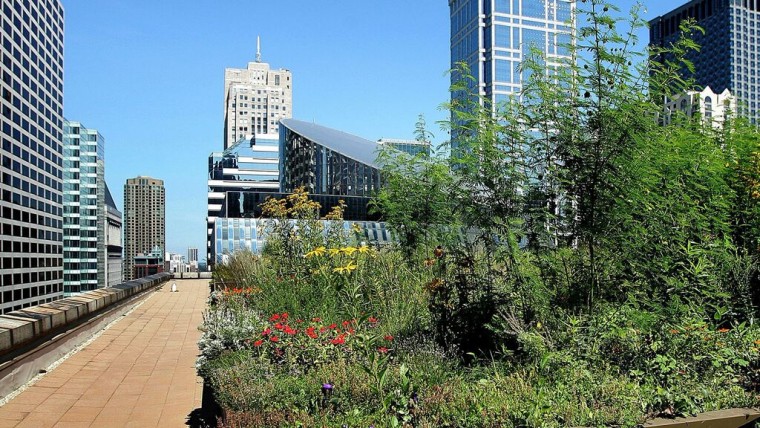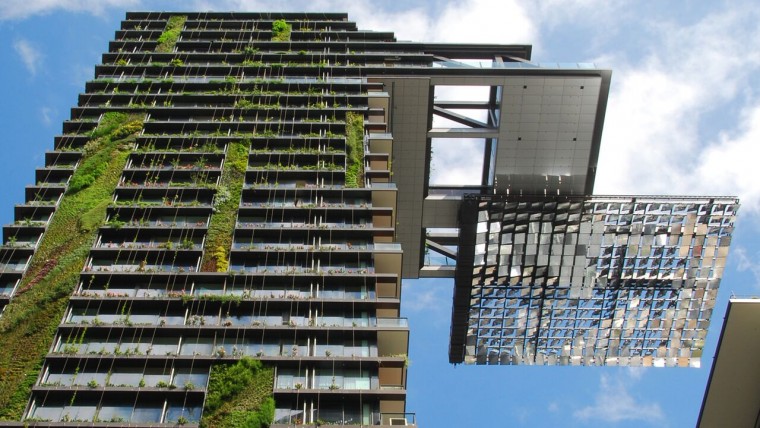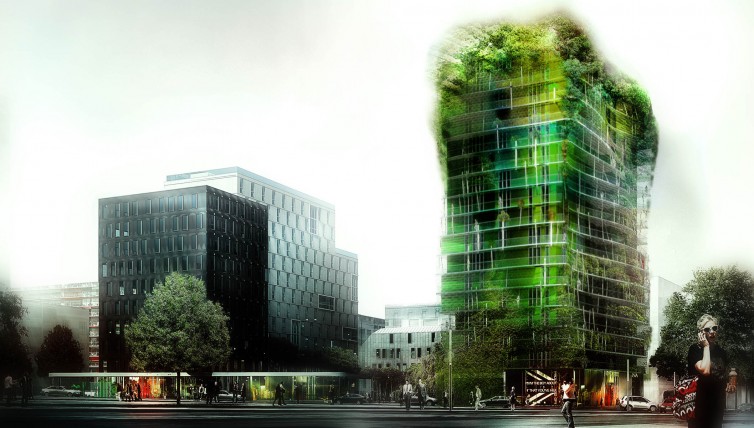Envy Rahm Emanuel. On top of his office in City Hall, the Mayor of Chicago can take a stroll among 20,000 plants from 150 different species. Should he feel particularly playful, he can even climb up into one of the roof’s two trees.
Chicago City Hall’s green roof delights many other Chicagoans too. And in the 13 years since it was completed, green roofs have become so common in cities around the world that citizens keen to visit one don’t have to rely on distant relatives or lottery luck for access.
“There has been a big change over the past decade,” says Dusty Gedge, president of the European Federation of Green Roof Associations. “Ten years ago, when I saw a crane, I’d hope that it was for a green roof. Now I know that it’s for a green roof.”
A big change indeed. According to a new report by market research firm Lux Research, in the past five years alone, the area covered by green roofs has grown from around 100 million square metres to some 150 million square metres, and by 2017 it’s predicted to reach 200 million square meters. The big growth will come from Asia and the Americas, while the European market is expected to stagnate.

Chicago City Hall’s green roof contains approximately 20,000 plants from 150 different species
“What’s driving the growth in green roofs is that they help storm water management because the plants, trees and soil on the roof help retain the water,” explains Lux Research analyst Jerrold Wang. “They also act as insulation, lowering heating and cooling costs. In addition, people like them because they feel that green roofs can help cities manage pollution and they like to see the roofs look beautiful.”
Green walls offer much the same attraction, but remain a much smaller market due to their technical challenges. A green wall is technically not part of the wall it covers, but an additional layer that is in most cases not attached to the wall itself. And, notes Mr Wang, while watering a green roof essentially just requires a watering can, watering a vertical garden involves expensive equipment. In total, building-integrated vegetation is now a $6-billion market, according to Lux Research’s report.
Virtually every major city now features at least one green roof or rooftop garden. Developers of new mega-buildings, such as New York’s Barclay Center, now add green roofs as a selling point. In Asia, the increasing popularity of green roofs is more to do with their air-cleansing attributes than with commercial positioning. According to a recent study, the severely polluted Chinese capital Beijing could save $4.7 billion by creating a comprehensive green roof programme.
No wonder, then, that Bangkok already has so many green roofs that a new one on top of the Siam Green Sky agricultural learning centre is just another addition to the mix, though at 2,000 square metres it’s a very large one, and it’s an innovative one as well, featuring a model farm where residents can learn traditional Thai farming techniques.
Green walls are, so to speak, also on the up. Thanks to Dutch architecture firm Venhoeven CS and countless plants and shrub, a run-down sports centre in Amsterdam has been transformed into what looks like a green fortress. In Sydney, the new One Central Park residential tower features an enormous vertical garden containing 25 species.

One Central Park residential tower in Sydney features an enormous vertical garden containing 25 species
Combining the two green solutions, Italian architect Stefano Boeri’s recently completed Bosco Verticale (vertical forest) skyscrapers in Milan feature trees and shrubs on every balcony [see main image.] Greywater from sinks, showers and washing machines in the building is used to irrigate the mini-forests, while solar panels on the roof generate energy.
In Copenhagen, architecture firm Jaja has adopted a similar approach in designing that superbly boring urban fixture, a garage car park. Jaja’s parking structure features staircases on outside walls, complemented by a multitude of planting boxes containing both trees and plants. The roof of the garage, to be completed later this year, will feature a playground.
In central London, the Rubens Hotel now features a 350 square-metre “living wall” consisting of 10,000 plants for the specific purpose of aiding wildlife. Buttercups, crocuses and strawberries have all been planted for the benefit of birds and butterflies.
So as the world continues to urbanise, future generations may, in fact, encounter wildlife not on the ground, but on walls and roofs. Though visitors to the Rubens Hotel and the Park’n’Play may not think of it that way, their lodging and parking thus provide an illustration of what the Harvard conservationist E.O. Wilson calls biophilic design. Human beings, he argues, have an innate affiliation with nature – biophilia.
“It’s funny,” says Edouard François, tongue in cheek. “Cities are changing their regulations in order to copy me.” The French architect has reason to marvel at how city planners have discovered the virtues of green walls, which he has been designing in cities as diverse as Casablanca, New Delhi and Paris.
Hotels and office buildings are not the only ones suited to green walls, as Mr François has shown by, for example, creating a green cocoon around an enormous ventilation shaft in Paris’s La Défence district. Yet the brains behind the M6B2 Tower of Biodiversity in Paris is not unreservedly enthusiastic about the green boom.

Design for the M6B2 Tower of Biodiversity in Paris, by architect Edouard François
“Developers don’t understand the nature of green walls,” he argues. “They’re doing them as make-belief; they simply want their walls painted green.” Irena Bauman, an architect in Leeds and professor of sustainable urbanism at the University of Sheffield, agrees. “There’s a lot of interest among a small group of architects who’ve developed a real understanding of the subject area and are breaking new ground,” she says. “The great majority, however, don’t have an interest in green architecture beyond what’s required to achieve compliance with regulations.”
Urban planners and legislators love architectural greenery for much the same reason: it offers practical benefits to their city and it looks pretty. “Cities know they have to adapt to climate change,” says Mr Gedge. “It’s a global phenomenon.” Indeed, cities ranging from Berlin to Singapore now have a mix of regulations and financial incentives in place in order to green their roofs. Today more than 14 per cent of Germany’s total roof area is green.
And which city dwellers would choose concrete homes and office buildings after they’ve entered ones surrounded by plants every day? The problem is, of course, that installing a whole horizontal or vertical garden costs far more than the plain concrete option.
Green roofs can reduce the energy needed for building cooling on the floor below the roof by upwards by 50 per cent
“But the difference will in many cases be counterbalanced by reduced energy and storm water management costs, and by having a longer lifespan compared to regular roofs,” says Esben Alslund-Lanthén, an analyst at the Copenhagen-based think-tank Sustainia.
A study from the National Resources Defense Council (NRDC) shows that temperatures on the surface of a conventional dark roof can increase the temperature in the air around it by 50C or more on a hot, sunny day. “By contrast, the temperature of a green roof may be cooler than the surrounding ambient air,” notes Mr Alslund-Lanthén. According to research by the NRDC, green roofs can reduce the energy needed for building cooling on the floor below the roof by upwards by 50 per cent.
Mr François, adding that he selects projects with developers who do understand green walls, remains upbeat about green buildings. “This is evolution,” he says. “Change happens slowly.”
In coming years that change is predicted to include more and more solar panels on roofs. “They can be part of the green roof construction,” says Mr Gedge. “We’ll sing the song of sustainability at the next level.”
For his part, Mr François doesn’t care for the so-called biosolar approach. He’s instead opted for creating access roads lined by solar panel and is raising the sustainability level in a different way altogether – through chickens. A building the Parisian architect is currently designing in Bordeaux features chickens in the courtyard. “It’s green because it’s life,” he says. Green buildings indeed.



